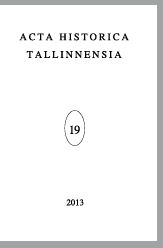KIRIKUD POLIITILISE SURVEGRUPINA: MAAILMALIIT RAHVUSVAHELISE SÕPRUSE EDENDAMISEKS KIRIKUTE KAUDU JA SELLE EESTI RAHVUSKOMISJON AASTATEL 19
CHURCH AS AN INTERNATIONAL PRESSURE GROUP: THE WORLD ALLIANCE FOR PROMOTING INTERNATIONAL FRIENDSHIP THROUGH THE CHURCHES AND THE AC
Author(s): Priit RohtmetsSubject(s): History
Published by: Teaduste Akadeemia Kirjastus
Keywords: Estonia; Estonian History; INTERNATIONAL PRESSURE GROUP ; WORLD ALLIANCE ; PROMOTING INTERNATIONAL FRIENDSHIP ; CHURCHES AND THE AC
Summary/Abstract: The aim of this article is to analyse the activity of the ecumenical peace organisation The World Alliance for Promoting International Friendship through the Churches and its Estonian national committee. Established in 1914, the Alliance as an instrument for promoting peace and friendship was interested in general problems of the world’s political order. As the representative of Christian and humanistic values and principles, the Alliance emphasised the fight for national minorities, refugees, as well as the opposition to religious persecution and the fight for the right to religious liberty. There was an understanding among the representatives of the Alliance that the organisation was the spiritual equivalent of the League of Nations, the soul of the League. The ideological basis, especially the lack of theological discussion as well as the fact that the Alliance distanced itself from other ecumenical organisations in establishing the World Council of Churches, turned out to be a drawback. For ten years after the First World War the methods of the Alliance seemed to work, but first due to the financial crisis beginning from 1929 and the ever straining situation in the international politics, the Alliance began to lose its clarity of vision and enthusiasm in its activity. The same kind of confusion was characteristic of the League of Nations. At the same time, the Alliance as a promoter of relations between different denominations made a significant contribution to the ecumenical movement. An example from Eastern Europe, namely from Estonia, can be given here, where the Orthodox and Lutheran churches were united in the national committee. According to the Constitution, there was a possibility of including other churches as well. When in most cases the activity of a national council rested upon the importance of churches in society, in Estonia the activity of the Alliance was hampered by the conflict inside the most influential member of the committee – the Lutheran Church. Although society was open to peace work, strained relations in the church shaped the conflicting image of the church in society. In addition, the conservative faction opposed to the idea of the church taking part in the ecumenical movement. At the end of the 1930s the state refused to register the new constitution of the Estonian national committee, because of the States’ policy to distance from establishing unions with foreign churches. The secretary of the Estonian committee, Prof. Eduard Tennmann, was the most influential ecumenical figure in the Baltic region. He was one of eight honorary secretaries of the Alliance. In the 1920s he initiated a plan to establish a Peace Academy of the Alliance, but because of the financial reasons the plan was dropped.
Journal: Acta Historica Tallinnensia
- Issue Year: 2013
- Issue No: 19
- Page Range: 061-088
- Page Count: 28
- Language: Estonian

